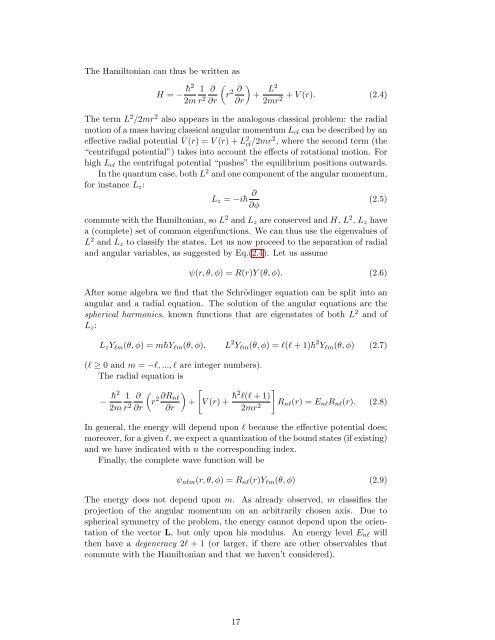Numerical Methods in Quantum Mechanics - Dipartimento di Fisica
Numerical Methods in Quantum Mechanics - Dipartimento di Fisica
Numerical Methods in Quantum Mechanics - Dipartimento di Fisica
You also want an ePaper? Increase the reach of your titles
YUMPU automatically turns print PDFs into web optimized ePapers that Google loves.
The Hamiltonian can thus be written as<br />
(<br />
H = − ¯h2 1 ∂<br />
2m r 2 r 2 ∂ )<br />
+ L2<br />
+ V (r). (2.4)<br />
∂r ∂r 2mr2 The term L 2 /2mr 2 also appears <strong>in</strong> the analogous classical problem: the ra<strong>di</strong>al<br />
motion of a mass hav<strong>in</strong>g classical angular momentum L cl can be described by an<br />
effective ra<strong>di</strong>al potential ˆV (r) = V (r) + L 2 cl /2mr2 , where the second term (the<br />
“centrifugal potential”) takes <strong>in</strong>to account the effects of rotational motion. For<br />
high L cl the centrifugal potential “pushes” the equilibrium positions outwards.<br />
In the quantum case, both L 2 and one component of the angular momentum,<br />
for <strong>in</strong>stance L z :<br />
L z = −i¯h ∂<br />
(2.5)<br />
∂φ<br />
commute with the Hamiltonian, so L 2 and L z are conserved and H, L 2 , L z have<br />
a (complete) set of common eigenfunctions. We can thus use the eigenvalues of<br />
L 2 and L z to classify the states. Let us now proceed to the separation of ra<strong>di</strong>al<br />
and angular variables, as suggested by Eq.(2.4). Let us assume<br />
ψ(r, θ, φ) = R(r)Y (θ, φ). (2.6)<br />
After some algebra we f<strong>in</strong>d that the Schröd<strong>in</strong>ger equation can be split <strong>in</strong>to an<br />
angular and a ra<strong>di</strong>al equation. The solution of the angular equations are the<br />
spherical harmonics, known functions that are eigenstates of both L 2 and of<br />
L z :<br />
L z Y lm (θ, φ) = m¯hY lm (θ, φ), L 2 Y lm (θ, φ) = l(l + 1)¯h 2 Y lm (θ, φ) (2.7)<br />
(l ≥ 0 and m = −l, ..., l are <strong>in</strong>teger numbers).<br />
The ra<strong>di</strong>al equation is<br />
(<br />
− ¯h2 1 ∂<br />
2m r 2 ∂r<br />
r 2 ∂R nl<br />
∂r<br />
) [<br />
]<br />
+ V (r) + ¯h2 l(l + 1)<br />
2mr 2 R nl (r) = E nl R nl (r). (2.8)<br />
In general, the energy will depend upon l because the effective potential does;<br />
moreover, for a given l, we expect a quantization of the bound states (if exist<strong>in</strong>g)<br />
and we have <strong>in</strong><strong>di</strong>cated with n the correspond<strong>in</strong>g <strong>in</strong>dex.<br />
F<strong>in</strong>ally, the complete wave function will be<br />
ψ nlm (r, θ, φ) = R nl (r)Y lm (θ, φ) (2.9)<br />
The energy does not depend upon m. As already observed, m classifies the<br />
projection of the angular momentum on an arbitrarily chosen axis. Due to<br />
spherical symmetry of the problem, the energy cannot depend upon the orientation<br />
of the vector L, but only upon his modulus. An energy level E nl will<br />
then have a degeneracy 2l + 1 (or larger, if there are other observables that<br />
commute with the Hamiltonian and that we haven’t considered).<br />
17
















